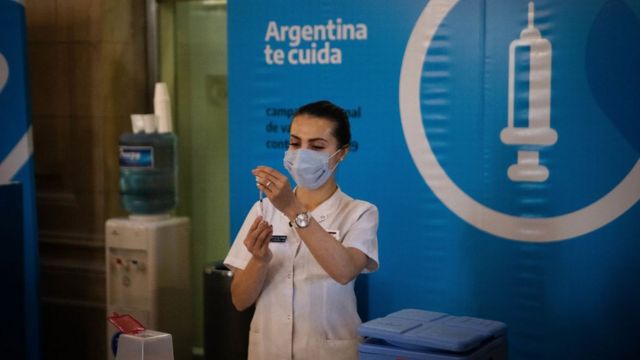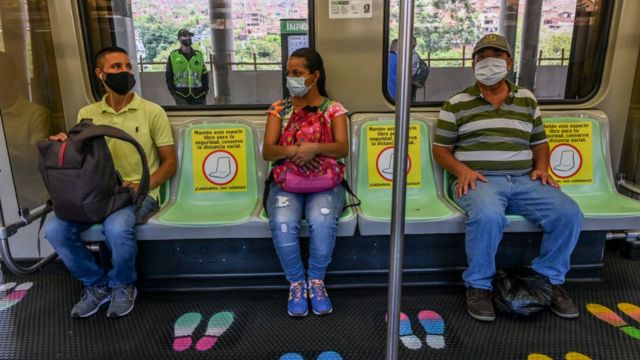By mid-June, while the rest of the world was experiencing low numbers of new coronavirus infections, South America was becoming the epicenter of the pandemic.
Seven of the 10 nations in the world with the most daily deaths per capita were in the region: Brazil’s rate was seven times that of India, while Colombia and Argentina had a figure that was equivalent to three times that registered in the entire African continent.
With just 5% of the world’s population, South America had a per capita death rate that was equivalent to eight times the world number.
But that is now a thing of the past.
At the end of June, the number of infections began to decline steadily, turning the region into one of the areas of the world where the pandemic seems to be better controlled.
Thus, while for this Monday the weekly average of confirmed cases per 100,000 inhabitants was 52 in the United Kingdom and 43 in the United States, Brazil only reached 8, Argentina to 6 and Colombia to 3, according to figures from Our World in Data.
Countries like Uruguay, which at the beginning of June had 100 cases per 100,000 inhabitants, now only have 4; while Paraguay, which registered up to 40 cases, now does not even reach 1 per 100,000 inhabitants.
This decrease in infections has been key so that South America is currently one of the regions of the world that is registering fewer cases of covid-19.
But how do you explain this abrupt drop in infections in South America?
Between immunity and other unknowns
“The first thing I would say to you is that I believe that we are not entirely clear“Responds Andrés Vecino, researcher in health systems at the Department of International Health at the John Hopkins School of Public Health (United States).
The researcher recalls that this is not the first time that there has been a decrease in cases that seems to announce that the end of the pandemic is approaching and then there is another wave of infections that shows that it was not.
“It is important to say that we don’t know exactly what this is and that the fact that cases are falling now does not mean that it will happen in the future. I want to remember what happened in India, where there was a relatively low count of cases for its population and then we saw a large increase in cases with the delta variant, “the expert warns BBC Mundo.

Dr. Carla Domingues, who led Brazil’s immunization program until 2019, recently issued a similar warning. “It is a phenomenon that we do not know how to explain,” said this epidemiologist to the newspaper The New York Times.
However, specialists give some clues: among them, vaccination. South American countries have accelerated the rate of inoculations in recent times, something that according to many experts could have contributed to curbing infections.
Vecino agrees, but does not point only towards vaccines but, more broadly, to the immunity acquired by the population of the region both through injections and infections.
“I think there is more or less consensus that it is possible that the reduction in cases in South America may be related to some degree of immunity in the population,” he highlights.
The expert explains that the different vaccines that have been applied in the countries of the region are an important element to consider, as is the immunity achieved by those who have already had the infection.
“Many people in some of those countries have been infected. A recent study they did in 12 cities in Colombia shows that the 89% of the people in these localities have already been infected. With that, one begins to think that it is possible that in some places there are such high levels of infection that we are already beginning to see a reduction in the disease, ”says the expert.
Vecino warns that, since the population is not homogeneous, this data cannot be interpreted as that 9 out of 10 people that one meets on the streets of those cities already had covid-19, so it is not necessary to trust.
“Individuals are related in groups, then there may be groups of people who still, for example, nO It has beenyesn infected nor have been vaccinated and these groups of people can have outbreaks if, for example, a highly transmissible variant such as mu, such as delta or gamma arrives, the 3 that are already in Latin America, so they can obviously cause an increase in cases and deaths, ”he explains.
“Having said that, it is possible that the level of immunity acquired by vaccines and previous infection is one of the reasons why we are seeing less transmission today,” he adds.
Applying the right measures
Ciro Ugarte, Director of Health Emergencies of the Pan American Health Organization (PAHO), confirms that there was a decrease in cases and deaths in almost all South American countries, with the exception of Venezuela.
Ugarte explains that PAHO is working with the ministries of Health and with experts in the region to study these trends, as well as the reasons why this decline has continued, and points to the tightening of control measures after the significant increase of cases in the region between the end of 2020 and the first months of 2021.
“Countries implemented much stricter measures Regarding physical distancing, the movement of people, the mandatory use of masks, they started vaccination and extended it to other groups, mainly those who were at greater risk. All of this may partly explain this trend, ”Ugarte says in response to a BBC Mundo query.
The director, however, warned the region against becoming complacent.
“We have seen that when the cases decrease it is because we are doing things well. In other words, we are implementing public health measures that have been proven over and over again that they continue to serve, ”he highlights.
“The worst thing that could happen to us and that could happen to the countries of South America is that now that they are with fewer cases relax the measures because that is a great opportunity for the virus to be transmitted from person to person ”, he warns.

Thus, although the number of cases is low at the moment, Ugarte considers that the appropriate thing is not to lower our guard:
“Our recommendation to the entire population of South America who is seeing that transmission is decreasing is to take into account that we are in that phase because the appropriate measures have been taken. Let’s not relax them ”.
eltiempolatino.com